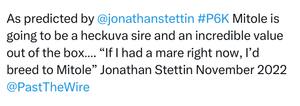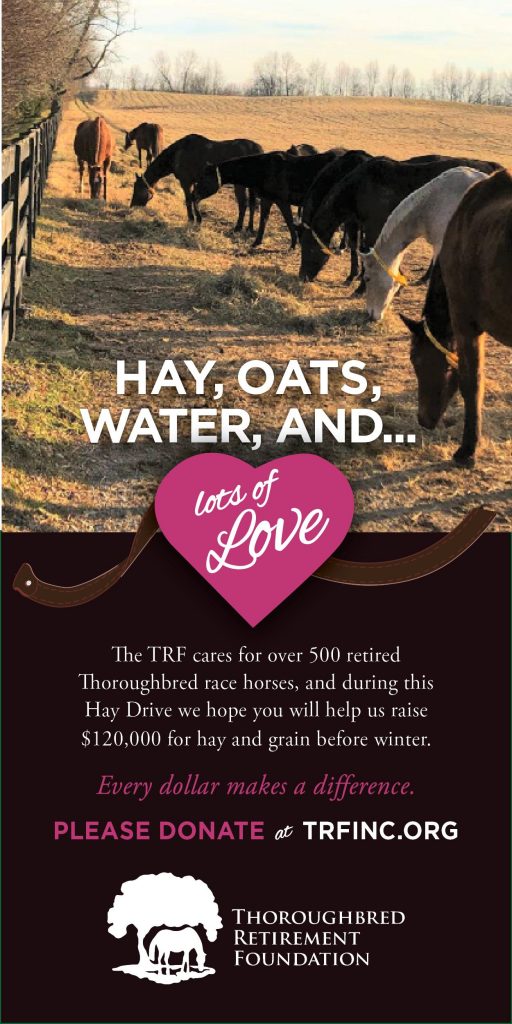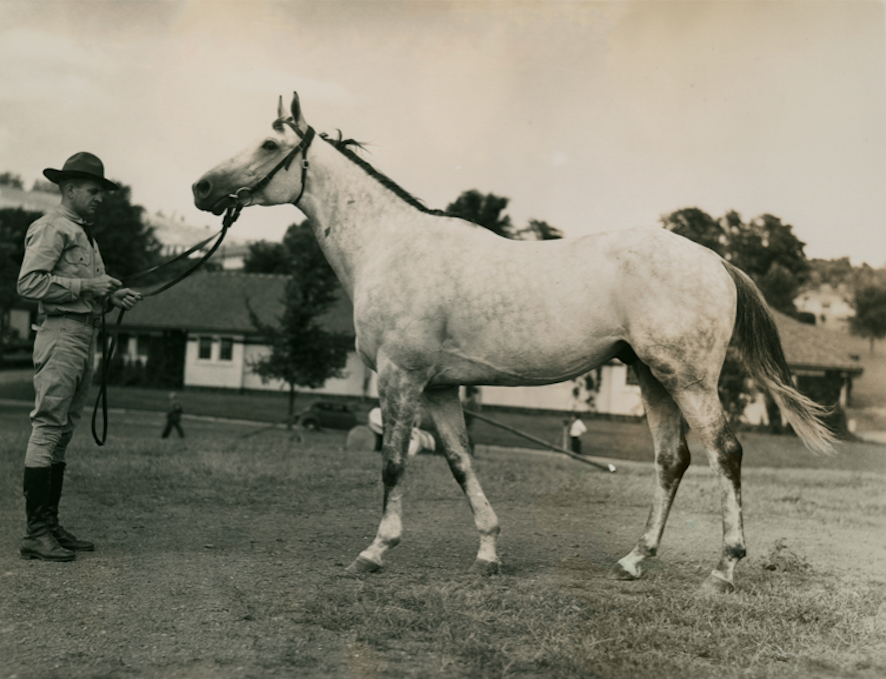
Jack Hare Jr., From the Preakness to the Army Remount Service
Sergeant Reckless, America’s Most Famous Equine Veteran
Many horses have served in the Armed Forces around the world. They carry troops and supplies in areas where vehicles cannot travel. They serve their country with integrity and courage. While most remained individually unknown to the general public there are a few who gained notoriety.
The Army Remount Service
To provide these horses the Army Calvary created the Remount Service where stallion owners were paid a nominal stud fee. Thoroughbreds were preferred, in particular, dark bay Thoroughbreds.
A part of the Quartermaster Corps, the U.S. Army Remount Service provided horses (and later mules and dogs) as remounts to U.S. Army units. Evolving from both the Remount Service of the Quartermaster Corps and a general horse-breeding program under the control of the Department of Agriculture, the Remount Service began systematically breeding horses for the United States Cavalry in 1918. It remained in operation until 1948, when all animal-breeding programs returned to Department of Agriculture control.
There was also a determined attempt to engage professional horse breeders in the Remount Service, beginning in 1918 with the approval of a breeding plan for cavalry horses that combined the efforts of the Remount Service with the Bureau of Animal Industry. A 1921 issue of the Cavalry Journal contained an update from the “American Remount Association” calling for owners of “high-class registered Thoroughbreds” to add their stallions to the program. The author also mentioned a reduced-cost registry for “half-breed” Thoroughbreds.
The number of horses involved in the program remained high even into the final years of the Remount Service. As late as 1945, between 450 and 500 stallions owned by the government and over 11,000 civilian-owned mares produced 7,293 foals. Thoroughbreds predominated in the stallion rolls, although a few Morgans, Arabians, and Standardbreds were also used. The number of Arabian stallions increased greatly in 1943 with the addition of the Kellogg Arabian Ranch (renamed the Pomona Remount Depot) to the program.
In 1942, the Remount Service (then called the Remount Division) printed a breakdown of its breeding program in the Cavalry Journal. According to the article, the primary breeding horse was the Thoroughbred (17,983 mares and 688 stallions), followed by Arabians (375 mares and 16 stallions), followed by Morgans, Saddlebreds, Anglo-Arabians, and the Cleveland Bay (trailing with eight mares and one stallion). Of the foals born in 1941, 11,028 of the 11,409 reported were Thoroughbreds.
From the Preakness to the Remount Services
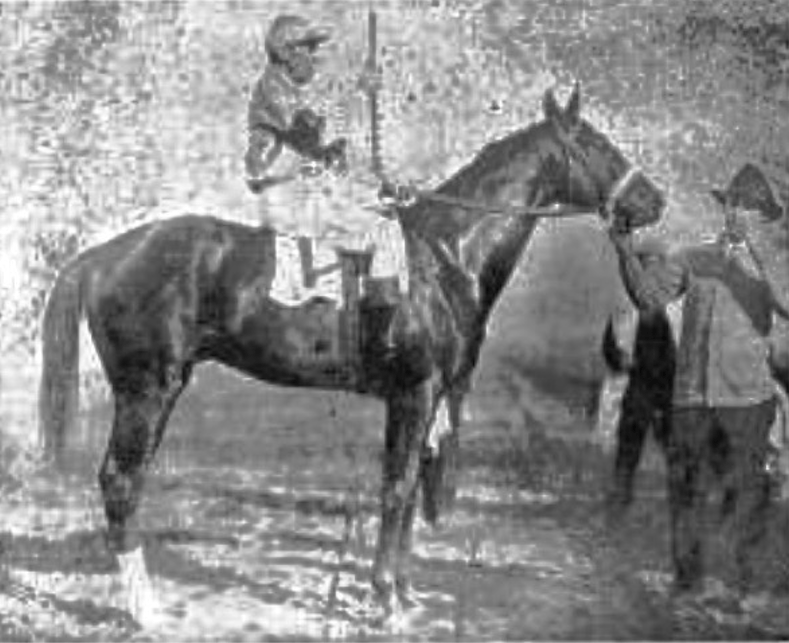
One of those Thoroughbreds was 1918 Preakness division two winner Jack Hare Jr. Although, this 3-year-old colt was one of two winners of the second jewel that year.
In 1918 due to an increase in the purse and thus, entries, the Preakness was split into two divisions. Jack Hare Jr. won the second division while War Cloud (GB), who never participated in the Remount Services, won the first division. War Cloud would stand at Claiborne until his death in 1923 from a broken leg. But this is Jack Hare Jr.’s story.
Jack Hare Jr. (1915-1929), bred by William E. Walsh, was sired by Marathon out of the mare Moonet, a daughter of Donald A. Owned by Colonel William E. Applegate, Jack Hare Jr. was under lease to R. T. Wilson, Jr., when he won the 1917 Grab Bag Handicap. He was initially trained by R. F. Campbell but was moved to Frank Weir by August 1917, later moving to the barn of Kay Spence.
Initially campaigned as a selling plater at age two, Jack Hare Jr. was widely considered to be one of the better juveniles of the year by the end of the 1917 season. He was not a great horse, but his tenacity made him a great favorite with Eastern fans who enjoyed seeing a “pony” take down much bigger rivals in good races. A small brown horse, Jack Hare Jr. was built like “a miniature bulldog” according to the New York Times of July 12, 1918, but was speedy and game. He was a front runner by preference and was an excellent weight carrier in spite of his small size.
As a two-year-old, Jack Hare Jr. did very well on the racetrack winning a maiden race, an allowance race, the Grab Bag Stakes, Liberty Bond Handicap, Troy Selling Stakes and Babylon Handicap all in 1917. The highlight of his freshman year was his win over War Cloud in the Nursery Stakes with a winning time of 1:11-2/5 for the six-furlong race.
Due to the split divisions, Jack Hare Jr. and War Cloud would not faceoff in the Preakness but it seems as though the best two 3-year-olds took the prize. Prizes, actually.
After his Preakness victory Jack Hare Jr. continued to race the balance of the year in 1918. He won five more stakes races that year namely the Wilmington Stakes, Woodberry Handicap, the Empire City Derby at Empire City Race Track and the Southampton Handicap at Jamaica Race Course in New York. The wily colt set a national track record in the Red Cross Handicap at Aqueduct of 1:44 2/5, 1 1/16 miles on dirt carrying 130 lbs.
He contracted pneumonia in September of his 3-year-old season, was out for the remainder of the season, and raced substantially below his previous form afterward.
As a 4-year-old, the brown colt would head south to compete in Kentucky where he won the Camp Knox Handicap, Eden City Handicap and Campbell County Handicap, the latter two both at Latonia Race Course. He would also place second in Falls City Handicap at Churchill Downs.
Jack Hare Jr. also had moderate success as an older horse winning the Booneboro Purse and Gibson Hotel Handicap at Latonia as a 5-year-old in 1920. He also placed second in the St. John Powers Memorial Handicap, a 6-furlong race 9m dirt at the Fair Grounds, and the Palace Handicap at eight furlongs at Latonia. In his 6-year-old year Jack Hare Jr. was second in the Quickstep Handicap at Latonia.
The small stallion was announced as being sent to stud in April 1920 after splitting a hoof but was back in action in claiming races by mid-June. For the next several years, he continued to race with short stints at stud interspersed, finally retiring from the track for good in 1923.
According to Sires and Dams of Stakes Winners 1923-1985 (Blood-Horse), Jack Hare Jr. sired 2 stakes winners (4.3%) from 46 named foals. The Jockey Club credits Jack Hare Jr. with 29 winners (63.0%). None of his progeny were of any great significance.
In November 1926, Jack Hare Jr. was moved to John Wiggins’ Military Stock Farm in Bourbon County, Ky., where he entered the into the U.S. Army Remount Services. In November 1928 the stallion then went to the Tattersalls auction at Lexington, Ky. The 1918 co-Preakness champ was sold to Rush McCoy for $400. His last registered foals were born in 1929. There is no record of his death or burial.
Sergeant Reckless, America’s Most Famous Equine Veteran
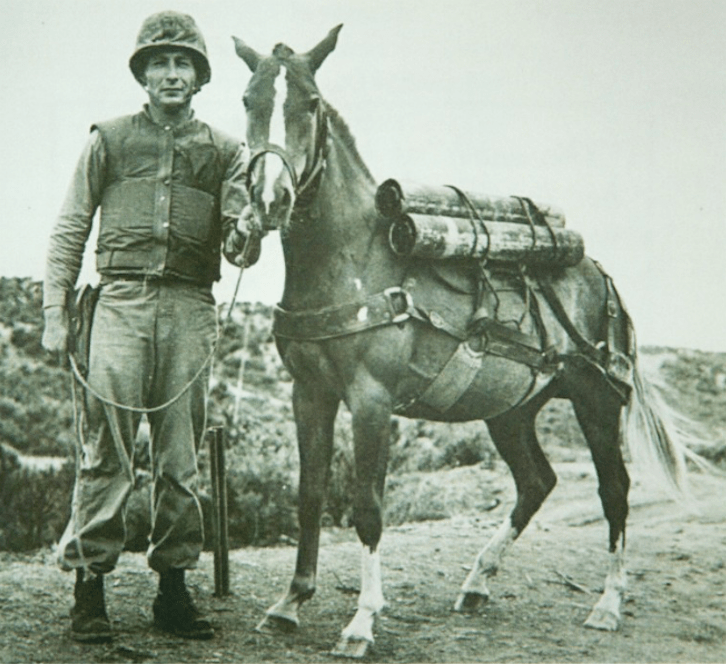
Sergeant Reckless came from humble beginnings. The small chestnut mare with the white blaze was out of a Korean race mare by an unknown Mongolian sire. She was estimated to be about three or four years old when the United States Marine Corps purchased her from owner in 1952.
Lieutenant Eric Pedersen needed a pack animal to carry artillery used by the Recoilless Rifle Platoon of the 5th Marine Regiment and having permission to make the purchase he went to the racetrack in Seoul to look for a horse. He found a man with a colt with a name that translated to “Flame-of-the-Morning” meaning morning light. Pedersen purchased the colt for $250.
The Marines renamed her “Reckless” as a contraction of the name of the Recoilless rifle and a nod to the daredevil attitude associated with those who used the gun.
Her primary trainer and the person who Reckless was closest to was platoon Gunnery Sergeant Joseph Latham. The Marines, especially Latham, taught Reckless battlefield survival skills such as how not to become entangled in barbed wire and to lie down when under fire. She learned to run for a bunker upon hearing the cry, “incoming!” The platoon called it her “hoof training” and “hoof camp.” The horse was initially kept in a pasture near the encampment.
Reckless’ most significant accomplishment came during the Battle of Panmunjom-Vegas (also known as the Battle of Outpost Vegas/Vegas Hill) over the period March 26–28, 1953, when she made 51 solo trips in a single day, carrying a total of 386 recoilless rounds (over 9,000 pounds, carrying 4 to 8 24-pound shells on each trip) covering over 35 miles that day. The whole Battle of Vegas lasted 3 days. She was wounded twice during the battle: once when she was hit by shrapnel over the left eye and another time on her left flank. For her accomplishments during the Battle of Vegas Hill, Reckless was promoted to corporal.
The 1st Marine Division was sent to a rest area soon after the move from Camp Casey to Inchon, and while there some platoon members posed with Reckless and a sign challenging the Thoroughbred Native Dancer to a race. They called their race the “Paddy Derby,” the field “Upsan Downs,” and the conditions differed from a typical horse race: 1.5 miles over paddies and hills, carrying 192 pounds of ammunition, and no riders. The Marines never received a reply; Native Dancer came in second in the Kentucky Derby, and went on to win the Preakness Stakes and Belmont Stakes.
Reckless had a gentle disposition and soon developed such a rapport with the troops that she was allowed to freely roam about the camp and entered tents at will, sometimes sleeping inside with the troops, and even lying down next to Latham’s warm tent stove on cold nights. She was fond of a wide variety of foodstuffs, entertaining the platoon by eating scrambled eggs and drinking Coca-Cola and beer. Food could not be left unattended around her.
The cheeky mare was known to eat bacon, buttered toast, chocolate bars, hard candy, shredded wheat, peanut butter sandwiches and mashed potatoes. The platoon was advised that she not be given more than two bottles of Coke a day. Her tastes were not confined to foodstuffs; she once ate her horse blanket, and on another occasion ate $30 worth of Latham’s winning poker chips.
Reckless was wounded in combat twice, given the battlefield rank of corporal in 1953, and then her battlefield promotion to sergeant in 1954, several months after the war ended. She was officially promoted to staff sergeant in 1959 by the Commandant of the Marine Corps.
For her exemplary service to the Marine Corps, Reckless was awarded two Purple Hearts (for the wounds received during the Battle of Vegas), a Marine Corps Good Conduct Medal, a Presidential Unit Citation with bronze star, the National Defense Service Medal, a Korean Service Medal, the United Nations Korea Medal, a Navy Unit Commendation, and a Republic of Korea Presidential Unit Citation. She would wear these awards on her horse blanket, plus a French Fourragere that the 5th Marines earned in World War I.
Reckless was led off the ship from Japan by Lieutenant Pedersen and set foot on American soil in San Francisco on November 10, 1954, coincidentally the birthday of the Marine Corps. For the Marine Corps Birthday Ball held that day, she rode an elevator, and then ate both cake and the flower decorations. The night before she arrived, she once again ate her blanket, but a new one with ribbons and insignia was made just in time for her disembarkation.
Reckless was kept by Pedersen’s family for a brief time before moving to a more permanent home with the 5th Marines, 1st Marine Division at Camp Pendleton. Reckless was well cared for and treated as a VIP during her time at Camp Pendleton.
The brave mare was retired from active service with full military honors at Camp Pendleton on November 10, 1960. She was provided free quarters and feed in lieu of retirement pay, per Marine Corps documents.
She produced four foals there. Three colts: Fearless (1957), Dauntless (1959), and Chesty (1964); her last foal, a filly born circa 1965–1966, died a month after birth and was unnamed. Her offspring Chesty was named after, Chesty Puller one of the few Marines ever allowed to ride Reckless. Puller was a Marine Corps Lieutenant General and the most decorated United States Marine of all time.
Reckless developed arthritis in her back as she aged and injured herself on May 13, 1968, by falling into a barbed wire fence. She died under sedation while her wounds were being treated. At the time of her death, she was estimated to be 19 or 20 years old.
The first race at Aqueduct was designated “The Sgt. Reckless” on November 10, 1989. In 1997, Reckless was listed by LIFE magazine as one of America’s 100 all-time heroes.
A plaque and photo were dedicated in her honor at the Marine Corps Base Camp Pendleton stables and a statue of her was dedicated on July 26, 2013, at the National Museum of the Maribe Corps in Quantico, Virginia. On May 12, 2018, a bronze statue of Sergeant Reckless was placed and dedicated in the Kentucky Horse Park, Lexington Kentucky.
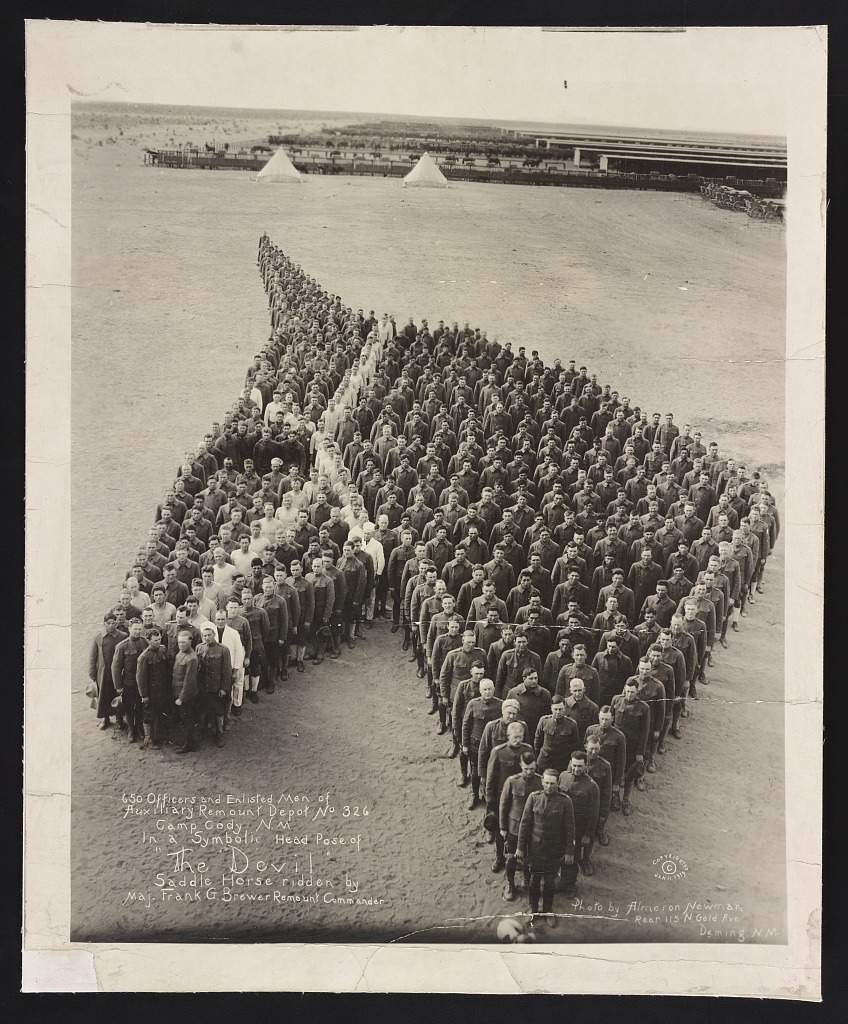
Top Photo: Remount Service Stallion “Silver Fleece”. Special Collections, USDA National Agricultural Library
Originally published Nov. 21, 2021. Updated May 30, 2022.


